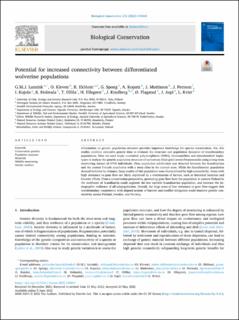Potential for increased connectivity between differentiated wolverine populations
Lansink, G.M.; Kleven, Oddmund; Ekblom, R.; Spong, G.; Kopatz, Alexander; Mattisson, Jenny; Persson, J.; Kojola, I.; Holmala, K.; Ollila, T.; Ellegren, H.; Kindberg, Jonas; Flagstad, Øystein; Aspi, J.; Kvist, L.
Peer reviewed, Journal article
Published version

Åpne
Permanent lenke
https://hdl.handle.net/11250/3001559Utgivelsesdato
2022Metadata
Vis full innførselSamlinger
- Publikasjoner fra CRIStin - NINA [2364]
- Scientific publications [1392]
Originalversjon
10.1016/j.biocon.2022.109601Sammendrag
Information on genetic population structure provides important knowledge for species conservation. Yet, few studies combine extensive genetic data to evaluate the structure and population dynamics of transboundary populations. Here we used single nucleotide polymorphisms (SNPs), microsatellites and mitochondrial haplo- types to analyze the genetic population structure of wolverines (Gulo gulo) across Fennoscandia using a long-term monitoring dataset of 1708 individuals. Clear population subdivision was detected between the Scandinavian and the eastern Finnish population with a steep cline in the contact zone. While the Scandinavian population showed isolation by distance, large swaths of this population were characterized by high connectivity. Areas with high resistance to gene flow are likely explained by a combination of factors, such as historical isolation and founder effects. From a conservation perspective, promoting gene flow from the population in eastern Finland to the northwest of Scandinavia could augment the less variable Scandinavian population, and increase the de- mographic resilience of all subpopulations. Overall, the large areas of low resistance to gene flow suggest that transboundary cooperation with aligned actions of harvest and conflict mitigation could improve genetic con- nectivity across Finland, Sweden, and Norway. Conservation genetics Population structure Mustelids Wildlife monitoring Genetic markers
